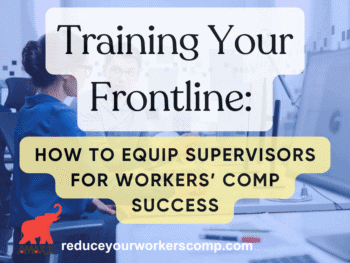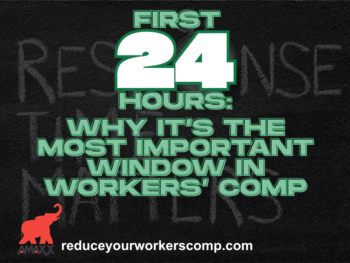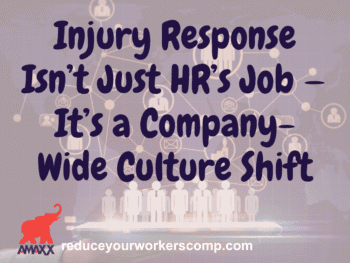It is never too late to start thinking about how to be more proactive when it comes to handling your insurance losses. You can implement a program or plan any time, provided you roll it out to the right people and your employees or workers understand the initiatives and reasons behind it.
Sometimes workers don’t understand how insurance works. Commercial insurance is a monster to address. It is hard to explain how an underwriter comes up with the numbers they do in order to assign a premium to your workplace. But the bottom line that should be communicated is that every dollar that goes out from the insurance company/TPA could affect the insurance cost. If you have higher costs, maybe you cannot give out higher bonuses. Or maybe increased costs result in certain workers not getting a pay raise. All workers will understand when you put it into a sense of how if affects them directly. So let’s go over some simple loss reduction techniques to refresh your mind for 2012:
1. Make a commitment to promoting safety
If you are going to do this, go all out. You need to establish the rules and procedures, and then you need to come up with a way to drill it into everyone’s mind. The perfect way is by having rules enforced, and violators punished. Not harsh, severe punishments, but more than a slap on the wrist. Make them park in the back of the lot. Make them wear a different color safety hat than everyone else, or a vest that claims they broke the safety rules. Have the punishment be something that is part tongue-in-cheek, but it gets the point across and leads to some good natured ribbing from other coworkers.
On the other side, reward safety achievements. Use gas cards or coupons for free food as gifts. Do raffles and hand out a few prizes to the person that was the most safety-oriented. Whatever you do, make the reward something more tangible than a pat on the back.
Also you can post safety rules and violations on signs and place them all over your work floor, in the bathrooms, in the break areas, etc. Make sure they are at eye-level where people can see them, and color them accordingly so they are hard to miss. Use diagrams and stick people to represent the injury that could occur if you stuck your hand into the saw blade with the machine on. If may seem elementary, but your workers will see those drawings everyday and probably laugh at them, but the more they look at them, the more they remember, and the safer they just might be.
2. Make safety paramount
When you have a safe work environment, you have more productive employees. This is due to the fact that your safe machines are running like they should. Nobody is worried about something breaking or someone getting injured by doing certain jobs. Safe workplaces have fewer workers comp claims.
Obviously there is a direct link between safety and work comp. The less safe you are, the more work comp injuries you will have. And that leads into higher premium exposure. If your claims skyrocket, the costs increase, and that could increase the cost of your premium for your work comp policy. So it all begins with safety. Safety is the key to keeping comp costs down. Which, in-turn, controls premium costs.
3. Have well-defined safety policies and the need to implement them
If workers are not following the safety rules, that is a problem. A rare violator that has to wear the vest of shame is one thing. But if you have a guy breaking the safety rules everyday, you have an issue. You have to investigate why the worker is not following the rules. Document your findings, and then follow through with safety training or re-education on the proper safety function for the particular machine or device they may be using. Maybe they were taught by another employee to use the machine incorrectly. Whatever the reason, investigate it, document it, then retrain and follow through until the person understands and is capable of safely operating the device or doing the work task within your defined safety rules and procedures.
4. Can the employer fire a worker that disobeyed a direct, known safety protocol?
Wow, is this a Pandora ’s Box of a question!!!!! There are numerous case law decisions within any jurisdiction that comment on this matter. I hear this question ALL THE TIME! The answer is "Yes, sometimes" and "No, at other times."
My advice is to always consult your counsel and adjuster before you do anything. Improper termination may open yourself to a world of fines and legal issues, and even though you think you may be doing the right thing that is not for you to decide. Consult your attorney before ever making such a decision. The choice will vary by accident, and no two will be the same.
5. Safety violations cost employers money!
If people are hurt, they cannot do their job, which decreases production, which in turn decreases profit. Jobs get completed late, others have to make up for the gap in work, etc. As mentioned earlier, safety violations in any form will always cost you money. The safer you are, the more productive, the more profitable.
Think Zero Accidents as your goal! People say, "Oh, that's impossible." But it's only impossible if you don't try.
6. High employee morale helps to reduce losses
Several studies show the link between morale and workers comp losses. Happy workers are happy because they have jobs they like; they have manageable workloads, safe working environments, etc. Disgruntled employees are overworked, underpaid, and under stress. They typically are working with potentially unsafe materials, in an unsafe shop, where there is a lot of risk for injury. Sooner or later they will stumble upon that risk, and injure themselves.
Actually the studies linking morale to work comp show they are linked up mostly in subjective injuries: back pain, muscle pain, headaches, etc. The more unhappy the workforce, the more subjective claims seem to surface.
7. Timely claim reporting saves money
And as always, and we say it time and time again, the sooner you get that work comp claim to your carrier to be assigned to an adjuster, the quicker they are on the case, the better the result will be. The more you delay in calling it in, the more it will cost you down the road. WCxKit
So, remember, it’s never too late to start thinking about safety, and how it impacts your bottom line. Think carefully about each job task and what risks your workers face. Solicit feedback from your employees. Involve them in this process, and hear what they have to say. The more they are involved, the more they will participate, and the more successful your program will be. Be safe!
Author Rebecca Shafer, JD, President of Amaxx Risk Solutions, Inc. is a national expert in the field of workers compensation. She is a writer, speaker, and website publisher. Her expertise is working with employers to reduce workers compensation costs, and her clients include airlines, healthcare, printing/publishing, pharmaceuticals, retail, hospitality, and manufacturing. She is the author of the #1 selling book on cost containment, Manage Your Workers Compensation: Reduce Costs 20-50% www.WCManual.com. Contact: RShafer@ReduceYourWorkersComp.com.
NEW 2012 WORKERS COMP BOOK: www.WCManual.com
WORK COMP CALCULATOR: www.LowerWC.com/calculator.php
MODIFIED DUTY CALCULATOR: www.LowerWC.com/transitional-duty-cost-calculator.php
SUBSCRIBE: Workers Comp Resource Center Newsletter
Do not use this information without independent verification. All state laws vary. You should consult with your insurance broker or agent about workers comp issues.
©2011 Amaxx Risk Solutions, Inc. All rights reserved under International Copyright Law. If you would like permission to reprint this material, contact Info@ReduceYourWorkersComp.com.


















